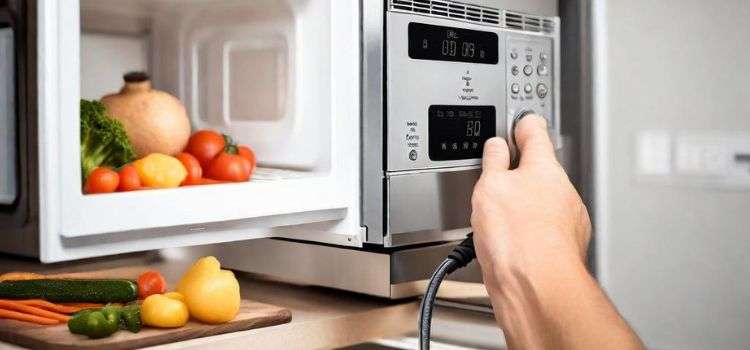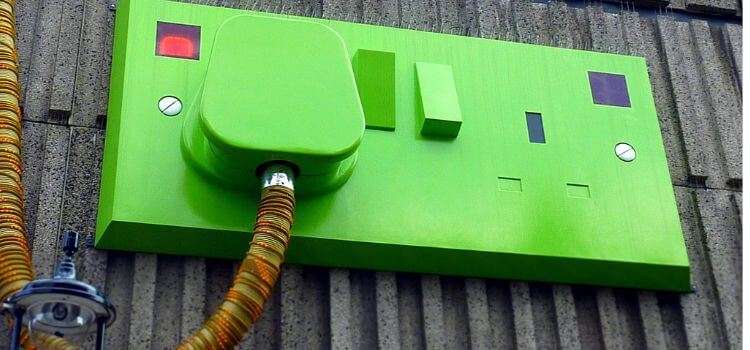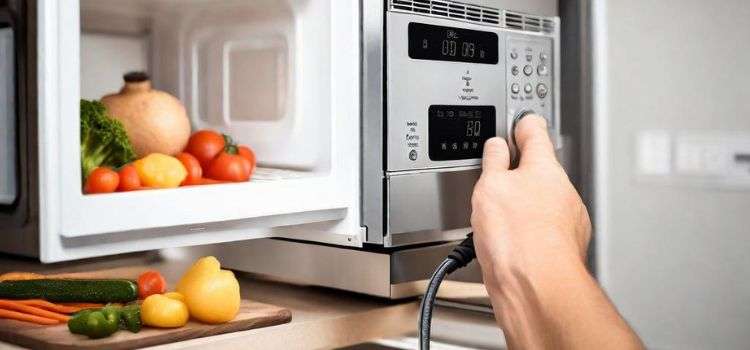The microwave oven has developed into a necessary device in the modern kitchen, saving us time and effort in our daily culinary endeavors. However, the placement of electrical outlets only sometimes aligns with our kitchen designs, and we often need extra reach.
This is where the question arises: can you plug a microwave into an extension cord? It seems like a practical solution, but there’s more to it than meets the eye.

In this article, we’ll delve into the world of extension cords, microwave power requirements, safety considerations, and best practices to help you make an informed decision and ensure both convenience and safety in your kitchen.
Let’s explore whether you can bridge the gap between your microwave and the outlet with an extension cord and what you need to know before doing so.
Understanding Extension Cords
Before delving into whether you can use an extension cord for your microwave, it’s essential to understand what extension cords are and how they work.
Extension cords are flexible, insulated cables with plugs at both ends, allowing you to connect electrical devices to a power source, even when the source is not within immediate reach. These cords come in various types, lengths, and power ratings designed for specific purposes.
The essential elements to think about when utilizing an extension cord include the type of cord, its length, gauge, amperage rating, and whether it’s suitable for indoor or outdoor use.
Microwave Power Requirements
To run a microwave oven, you need to understand the power requirement. You can damage your appliance or burn yourself if you don’t have enough wattage. You can damage the cord or outlet if you don’t have enough amperage. Let’s look at the difference between wattage, amperage, and recommended load capacity.
Wattage is the amount of power that a cord can handle. Wattage refers to the number of watts, a measurement of power. If you have a 1000-watt cord, the cord can handle up to 1000 watts of electricity. The higher the wattage, the greater the power. It is possible to use a 1000-watt cord to operate a 12,000-watt appliance.
Amperage refers to the current, the volume of electrical current flowing through a circuit. Amperage also measures the rate at which electrons flow through a wire. The amperage rating of a cord tells you how much amperage the cord can handle.
For example, a 300-ampere cord is made of copper so that it can handle 300 amps of current. The recommended load capacity is the maximum capacity a cord is designed for. The load capacity determines the load that can be applied to the cord without damaging it.
Load capacity is indicated in the label or tag on the cord. The load capacity of an extension cord is specified in watts. For example, a 30-watt extension cord can handle 30 watts of power. When using an extension cord, it is essential to know the rated power of the cord to avoid damaging your appliance. If you have a 60-watt cord, it can handle only 6 amps of current.
Read More: How To Get Wrinkles Out Of A Vinyl Tablecloth
Typical Microwave Wattage
The typical microwave wattage ranges from 600 to 1,200 watts, depending on the model. Microwaves also require a specific amperage to function correctly. It’s crucial to consider these power requirements when considering whether to use an extension cord.
Safety Considerations
When operating a microwave while using an extension cord, safety should be your primary concern. Here are some important safety considerations:
Choose the Right Cord: Select the appropriate extension cord type and length for your specific application. Ensure it has the necessary gauge and amperage rating.
Inspect Regularly: Check your extension cords for wear, fraying, or damage. Replace any damaged cords promptly.
Avoid Overloading: Avoid exceeding the cord’s amperage rating by connecting too many devices or high-power appliances. Overloading can lead to overheating and fire hazards.
Unplug When Not in Use: When devices are not in use, unplug them from the extension cord to prevent energy waste and reduce the risk of electrical issues.
Route Cords Safely: Position extension cords away from high-traffic areas to prevent tripping hazards. Do not pinch or crimp cords by closing doors or windows on them.

Best Practices for Using an Extension Cord with a Microwave
An appliance that heats food using electromagnetic radiation is a microwave oven. You must follow specific safety rules to ensure that the microwaves cook your food correctly. Always use the correct type of oven for your particular food.
Never use a microwave oven to reheat leftovers or foods that have already been cooked. If your microwave has an automatic power switch, turn the power off and unplug the unit before placing food in the oven.
If the microwave does not have an automatic power switch, remove the cover before heating. When you are using your microwave oven, follow these safety tips to help ensure that it doesn’t malfunction. Use oven mitts to avoid hot splashes and spills.
Keep your children and pets away from the microwave. Turn the microwave off and unplug it when you are done cooking. Never put anything into the microwave that you don’t want to burn.
Alternatives to Using Extension Cords for Microwaves
When considering how to power your microwave, it’s important to explore alternatives to using extension cords. These alternatives not only enhance safety but also contribute to a more organized and efficient setup. Relocating the microwave to an area with an existing electrical outlet can simplify your power source.
Consulting an electrician for additional outlet installations or dedicated circuits is a long-term solution that ensures both convenience and safety. Various methods of managing cables include cord organizers and cable channels, keeping cords neat and minimizing clutter. For occasional use, extension cord reels can help with storage and prevent tangles.
Additionally, battery-powered microwaves and countertop convection ovens offer cordless options, making them suitable for specific needs. By considering these alternatives, you can create a safer and more tailored power solution for your microwave, enhancing both functionality and aesthetics in your kitchen or workspace.
Read More: How To Clean Foam Kitchen Mats
How to Plug in Your Microwave?
You must have an electrical outlet if you want to plug in your microwave. You can plug in your microwave using the same outlet you use for your stove or refrigerator. However, before you plug in your microwave, you should know which type of power source you are going to use.
A dedicated circuit for your microwave uses a separate circuit for your microwave. A dedicated circuit is used to ensure that the power is always available for your microwave. You can purchase these from a home improvement store.
It would be best if you had an electrical outlet in the area where you will place your microwave. Before you plug in your microwave, consult your power source to make sure you have enough outlets for all the power that you need. It is a good idea to turn off the power source before you connect it to your outlet.

How to Repair the Damage Extension Cords for Microwaves?
If you need to repair extension cords, the first step is to ensure the cord is disconnected from the wall outlet before you begin the job. Then, you need to remove the cover from the outlet so that you can make the necessary repairs.
After you have made the necessary repairs, you should cover the outlet with the original cover that came with it. Finally, you should test the repaired cord before connecting it to the wall outlet.
Conclusion
In conclusion, it is possible to plug a microwave into an extension cord in certain situations, but it is not recommended due to the safety risks involved. If you must use an extension cord, ensure it’s of high quality, suitable for the task, and in good condition.
However, the best practice is to avoid using an extension cord with high-power appliances like microwaves whenever possible, as it ensures the safety of both your appliances and your home. Prioritizing safety when dealing with electrical connections is essential to prevent accidents and potential hazards.
Frequently Asked Questions(FAQ) About Can You Plug A Microwave Into An Extension Cord?
Are there any specific extension cords that can be used with a microwave?
If you must use an extension cord, it’s crucial to choose one rated for the same wattage or amperage as your microwave. Look for heavy-duty extension cords that are designed for high-power appliances, but even then, it’s generally safer to avoid using an extension cord with a microwave altogether.
What’s the best practice for plugging in a microwave?
The best practice is to plug your microwave directly into a wall outlet. This ensures that the microwave gets a stable power supply and reduces the risk of electrical issues or safety hazards associated with extension cords.
What should I do if my microwave’s cord is not long enough to reach the outlet?
If your microwave’s cord is too short to reach the outlet comfortably, consider having a qualified electrician install a new outlet closer to your microwave’s location. This is a safer and more reliable solution than using an extension cord.
Can I use a surge protector or power strip for my microwave instead of an extension cord?
Using a surge protector or power strip designed for high-power appliances may be safer than an extension cord, but it’s still not recommended. These devices are not typically designed for continuous high-current use and can also pose safety risks. Extending your wall outlet or relocating your microwave if needed is better.
What are the risks associated with using an extension cord with a microwave?
Overheating, cord damage, and fire hazards are the main risks. An extension cord not rated for the microwave’s power needs can overheat, potentially melting or damaging the cord insulation and increasing the fire risk.
Can using an extension cord with a microwave void its warranty?
It’s essential to check the manufacturer’s warranty information for your microwave. Some warranties may become void if you use the appliance with an extension cord, as this practice can lead to electrical problems.
Are there any alternatives to using an extension cord with a microwave?
As mentioned earlier, the safest alternative is to install a new outlet closer to your microwave or relocate the appliance to be within reach of an existing outlet. In addition to lowering safety concerns, this removes the need for an extension cable.
What should I do if I’ve already used an extension cord with my microwave?
If you have been using an extension cord with your microwave, it’s advisable to stop immediately and relocate the microwave to a wall outlet. Check the extension cord and microwave for any signs of damage. If you suspect any issues, consult a qualified electrician to assess and address any potential electrical problems.
How much power does a microwave take?
The amount of power depends on the model. Some microwaves take 50 watts, while other models use 750 watts.
Is plugging a microwave into an extension cord dangerous?
No, it is not dangerous to plug a microwave into an extension cord.
As an Amazon Associate, I earn from qualifying purchases

